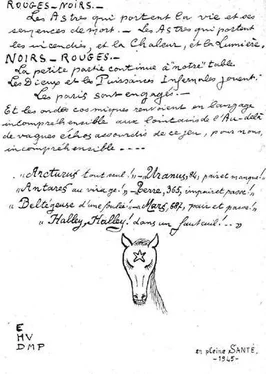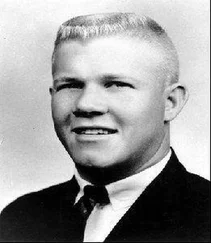After learning that the young man wished to leave as soon as possible, the doctor told him of his “extraordinary luck” in that a group was leaving the following morning. He would travel through Casablanca, as Guschinow had been told five months earlier. “Given the circumstances,” Petiot said, “I would advise you to take with you as much money as possible.”
Raphaël was instructed to write letters to relatives. As he was single, he wrote to his parents, telling them not to worry and that he would return home when the situation improved. In Raphaël’s case, he was asked to write the letters before he arrived at the meeting with the physician. This was not likely standard procedure. For one thing, in the case of other letter writers, like Van Bever, Khaït, and Braunberger, each one had disappeared without warning, and as they did not carry any luggage, it is not likely that they carried any letters informing of their departure, either. It is also possible that the procedure was later changed. Raphaël would have been one of the early travelers in the false network.
The evening of the departure, Petiot escorted Raphaël to rue Le Sueur. “Still decided? Are you really afraid?” Petiot asked his new client, who answered that he was not. “Good, so much the better.” He took the young man into his office, which was where Massu placed it, in the outside building, with the polished desk, armchairs, and magazines on the table. The applicant was told to enter a room down the corridor where he should await departure. This was the triangular room. He was told he would leave from this room, exiting onto a side street, today’s rue Bois de Boulogne. A chauffeur would soon arrive to take him on his journey to freedom. Raphaël did not know this, but the so-called exit was the false door inspectors found glued onto the wall.
“You see, it is important that you completely master your nerves,” Petiot advised his client, explaining the difficulties that lay ahead. Raphaël remembered the physician telling him that he would probably have to go three days at least without sleep. To help him cope with the physical and mental challenges of the escape from Occupied Paris, Petiot offered an injection.
The injection was not by a distance-operated syringe, as Nézondet claimed, attributing the story to Maurice Petiot. It was probably an ordinary hypodermic needle; it did not elicit any special description or commentary. After the injection was administered, Dr. Petiot escorted Raphaël into the small room and returned to his “office.” Raphaël was now alone in the triangular room. There was no forced entry or incarceration. He was free to walk around the room. He stared at the bare walls. No windows, a door with a button, and an odd array of hooks. He waited. He sat down on one of his suitcases. It was completely silent.
As he described the sensation, he began to feel weak. His head became heavy, his heartbeat seemed to slow, and he felt a sudden sense of fatigue. There was still no sign of the chauffeur or the doctor, who he thought must have been detained by a patient. Then, as Raphaël described it, he felt an “unbearable torpor seize [him].”
After what seemed like several hours, though of course he could not say for sure, Raphaël woke up in a great deal of pain. He compared it to being “spread out on a pile of wood or on iron bars.” His wrists, he discovered, were now locked in iron bolts, and so were his ankles. A rope, tied from the ceiling, passed around his body. He was now hanging on the wall, suspended from the iron hooks. He could not move. He felt exhausted and nauseous, with an excruciating pain in his back. His ears buzzed, his muscles cramped, and he saw visions. His head was more congested than at any time of his life. His body was one big overwhelming pain. Everything felt hopeless, he said, but he knew that his only chance of survival was to maintain hope.
Suddenly it became difficult to breathe. As he described it, the room was overtaken by a “stinking atmosphere.” He believed it was carbon monoxide, but as he was not a chemist and that particular gas has no odor or taste, this could not be correct. A gas of some sort, however, had entered the room. What was it?
In the 1980s, an unidentified former member of the French Gestapo living in South America gave a startling admission to a French historian using the pen name “Henry Sergg” while writing the book Paris Gestapo . In a wide-ranging conversation, accompanied by a glass or two of tequila, the former French Gestapo member mentioned that some people in his gang knew how Dr. Petiot killed his victims. The standard theory of death by injection was, as he put it, “a load of crap.” What Petiot did was gas them. Of course, a single anonymous source cited by a historian using a pseudonym is hardly ideal evidence (at the time, historians researching the French Gestapo still received death threats). That comment passed without much notice and no other biographer besides Sergg has mentioned it.
But in light of Raphaël’s testimony, this claim deserves more consideration. In fact, the former French Gestapo member identified the gas as hydrogen cyanide. HCN, or “prussic acid” for its blue color, is a highly poisonous gas that enters the body not only through the lungs, but also the eyes, the skin, the gastrointestinal tract, and the mucous membranes. It attacks the oxygen in the blood and the central nervous system, causing the organism’s cells and living tissue literally to suffocate. Hydrogen cyanide is also the gas that the Nazis used at Auschwitz and other death camps.
When Petiot began his renovations at 21 rue Le Sueur, the first known Nazi experiments with this particular gas had taken place in Block 11 of the Auschwitz Main Camp on September 3, 1941. It was a doctor, SS Colonel Dr. Viktor Brack, who had first suggested hydrogen cyanide to the Nazi elite, who were then looking for a more efficient and faster way than carbon monoxide to implement the “Final Solution.” Six months after this first experiment, which killed some six hundred Soviet POWs and three hundred Poles and Polish Jews, the Nazis had begun using hydrogen cyanide at the new gas chamber at Auschwitz-Birkenau. By this time, Petiot’s triangular room had been completed for nine months.
Petiot did not need Zyklon B, the commercial form of hydrogen cyanide that the Nazis used. He could create the deadly gas by dropping pellets of cyanide of potassium into a bucket of sulfuric acid and distilled water—which is indeed what the French Gestapo member said that he did. As for the electric heater that Massu found outside the triangular room and stood on to look through the Lumvisor lens, it probably had a different purpose. Hydrogen cyanide gas only becomes volatile at seventy-five degrees Fahrenheit. On cold days of winter and spring, Petiot’s electric heater would raise the temperature enough to begin vaporization.
When the lethal gas attacks the cells, preventing them from processing oxygen, the victim gasps for air, sometimes gurgling or foaming at the mouth, the head moving up and down to the chest and side to side. The victim may then writhe in pain, with violent body spasms and convulsions. The heart might start and stop again for minutes in a prolonged, agonizing confusion of life and death. It is a horrific demise. Petiot installed a Lumvisor to watch every detail.
Or did he? Since the first use of the gas chamber, actually by the Nevada State Penitentiary at Carson City on February 8, 1924, the chambers have been equipped with a viewing lens as a safety precaution. As this particular gas forms clouds that would fill the room, the question arises: did Petiot really intend to enjoy the spectacle, or was it simply a means of indicating when it was safe to reenter the room and begin airing it out? At any rate, the triangular room was indeed a torture chamber, an even more disturbing one than imagined.
Читать дальше












